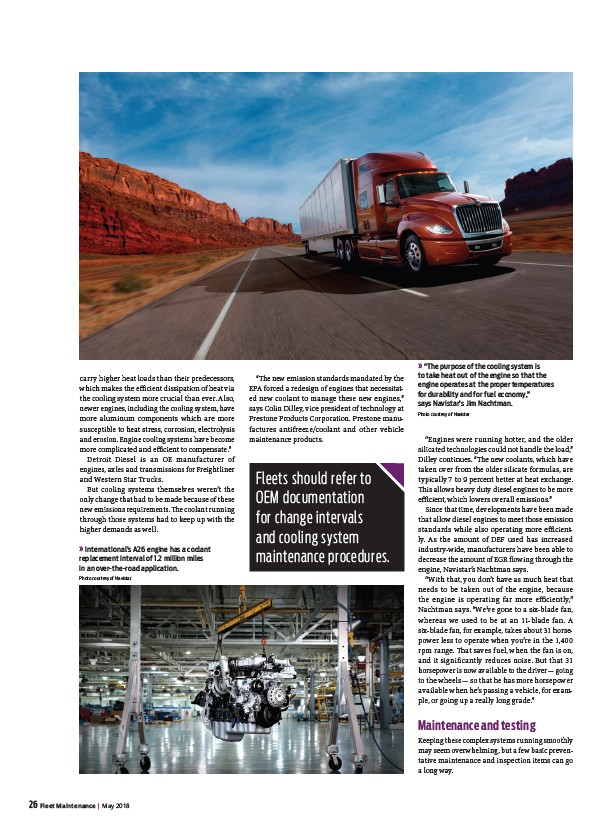
carry higher heat loads than their predecessors,
which makes the effi cient dissipation of heat via
the cooling system more crucial than ever. Also,
newer engines, including the cooling system, have
more aluminum components which are more
susceptible to heat stress, corrosion, electrolysis
and erosion. Engine cooling systems have become
more complicated and effi cient to compensate.”
Detroit Diesel is an OE manufacturer of
engines, axles and transmissions for Freightliner
and Western Star Trucks.
But cooling systems themselves weren’t the
only change that had to be made because of these
new emissions requirements. Th e coolant running
through those systems had to keep up with the
higher demands as well.
26 Fleet Maintenance | May 2018
“Th e new emission standards mandated by the
EPA forced a redesign of engines that necessitated
new coolant to manage these new engines,”
says Colin Dilley, vice president of technology at
Prestone Products Corporation. Prestone manufactures
antifreeze/coolant and other vehicle
» “The purpose of the cooling system is
to take heat out of the engine so that the
engine operates at the proper temperatures
for durability and for fuel economy,”
says Navistar’s Jim Nachtman.
Photo courtesy of Navistar
maintenance products. “Engines were running hotter, and the older
silicated technologies could not handle the load,”
Dilley continues. “Th e new coolants, which have
taken over from the older silicate formulas, are
typically 7 to 9 percent better at heat exchange.
Th is allows heavy duty diesel engines to be more
effi cient, which lowers overall emissions.”
Since that time, developments have been made
that allow diesel engines to meet those emission
standards while also operating more effi ciently.
As the amount of DEF used has increased
industry-wide, manufacturers have been able to
decrease the amount of EGR fl owing through the
engine, Navistar’s Nachtman says.
“With that, you don’t have as much heat that
needs to be taken out of the engine, because
the engine is operating far more effi ciently,”
Nachtman says. “We’ve gone to a six-blade fan,
whereas we used to be at an 11-blade fan. A
six-blade fan, for example, takes about 31 horsepower
less to operate when you’re in the 1,400
rpm range. Th at saves fuel, when the fan is on,
and it signifi cantly reduces noise. But that 31
horsepower is now available to the driver — going
to the wheels — so that he has more horsepower
available when he’s passing a vehicle, for example,
or going up a really long grade.”
Maintenance and testing
Keeping these complex systems running smoothly
may seem overwhelming, but a few basic preventative
maintenance and inspection items can go
a long way.
» International’s A26 engine has a coolant
replacement interval of 1.2 million miles
in an over-the-road application.
Photo courtesy of Navistar
Fleets should refer to
OEM documentation
for change intervals
and cooling system
maintenance procedures.